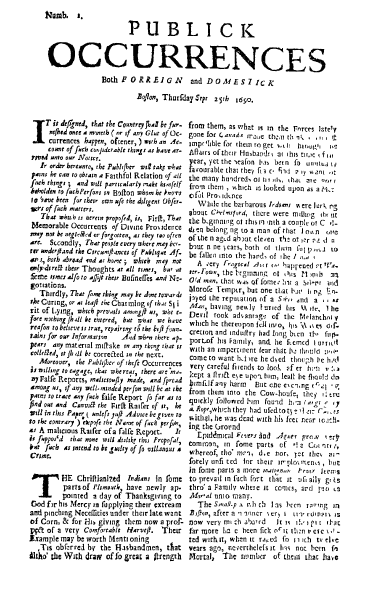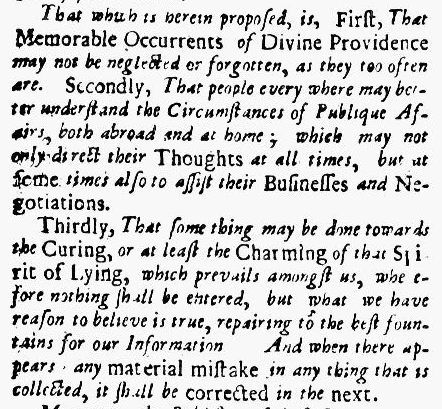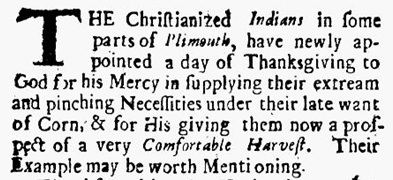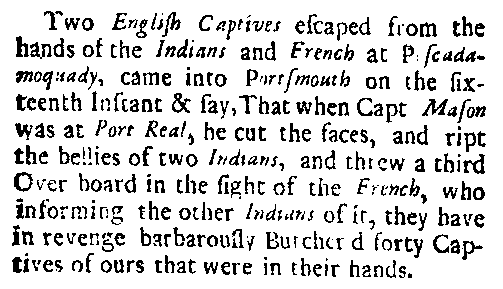Introduction: Duncan Kuehn is a professional genealogist with over eight years of client experience. She has worked on several well-known projects, such as “Who Do You Think You Are?” and researching President Barack Obama’s ancestry. In this blog post, Duncan writes about the short-lived history of the first newspaper in America – which was shut down by the authorities after printing its first and only issue.
Publick Occurrences Both Forreign and Domestick was the first American newspaper published. Previously a few broadsides had been published in the colonies, but these were single-sided sheets of news or announcements meant to be posted in a public place. Publick Occurrences was the first real newspaper, consisting of three pages of news intended for individual consumption. This newspaper is a fascinating study of early North American life and times.

The History of the First Newspaper in America
The editor, Benjamin Harris, had published a newspaper and other material in London, but ran afoul of the authorities and was twice jailed for his “seditious” pamphlets – so in 1686 he immigrated to the American colonies. He enlisted the help of a local printer, Richard Pierce, and together they produced their four-page newspaper on 25 September 1690 in Boston. It was about six inches by ten inches and the last page was blank.
Harris and Pierce used the first few column inches of the new paper to explain their reasons and hopes for creating it. They intended to provide “an Account of such considerable things as have arrived unto our Notice” for three reasons:
- “That Memorable Occurrences of Divine Providence may not be neglected or forgotten, as they too often are.”
- “That people every where may better understand the Circumstances of Publique Affairs, both abroad and at home; which may not only direct their Thoughts at all times, but at some times also to assist their Businesses and Negotiations.”
- “That some thing may be done towards the Curing, or at least the Charming of that Spirit of Lying, which prevails amongst us, wherefore nothing shall be entered, but what we have reason to believe is true, repairing to the best fountains for our Information.”

A Day of Thanksgiving
The first article was about the “Christianized Indians in some parts of Plimouth” having “newly appointed a day of Thanksgiving to God for his Mercy in supplying their extream and pinching Necessities.” It went on to opine that: “Their Example may be worth Mentioning.”
This was an excellent beginning article for the new paper, a nice human interest story which caused no controversy. It will be remembered that in 1690, there was no independent nation and no national Thanksgiving holiday in North America. However, the colonists and their Christianized Indian allies observed periodic days of thanksgiving.

Suicide after Wife’s Death
For the genealogist, this paper is full of stories of importance. For example, one front page article relates the story of an older resident of Watertown who committed suicide after the death of his wife. This man “had long Enjoyed the reputation of a Sober and a Pious Man; having newly buried his Wife, The Devil took advantage of the Melancholy which he thereupon fell into.” Despite the efforts of his friends to protect him, he slipped away one night and hanged himself. His name was not mentioned, but it might be possible to discover his identity using the clues given in the old newspaper article.
Small Pox Ravages Boston
There are stories about illness, including one about small-pox that had recently ravaged Boston:
The Small-pox which has been raging in Boston, after a manner very Extraordinary, is now very much abated. It is thought that far more have been sick of it than were visited with it, when it raged so much twelve years ago, nevertheless it has not been so Mortal. The number of them that have dyed in Boston by this last Visitation is about three hundred and twenty, which is not perhaps half so many as fell by the former [visitation].
Again, no names are mentioned, but it may provide clues on ancestors affected by this calamity.
Inferno Engulfs Town
Another story tells of a fire that took the life of one boy and destroyed five or six homes and a rare and valuable printing press: “…[one] of those few that we know of in America, was lost; a loss not presently to be repaired.”
Children Taken as Indian Captives
Another story is about two Chelmsford children, ages 11 and 9, kidnapped by the hostile Indians. While these stories don’t mention the individuals by name, they can provide clues for identifying individuals you may already know something about from other records. In addition, these stories can provide an incredible look into the life and times of the residents of Boston. What were they most concerned with? What was life like? How did they adapt to their circumstances? And so on.
French vs. English
There is another story about an English ship that put in at the wrong port and was attacked by the French and their Indian allies, with one member of the crew escaping. Although the French and Indian War did not officially begin until 1754, we see in these 1690 reports that clashes between the French and English – and their respective Indian allies – were common.
In fact, the majority of this inaugural (and, as it turned out, only) issue of Publick Occurrences’s articles address the ongoing fighting. They graphically describe the various conflicts with a remarkable nonpartisanship, with blame assigned to both the French and English, as well as their Indian allies. As a British citizen, Harris could justify a printed attack on the French and their Indian allies. He reports how the French Canadians even annihilated some loyal Indian allies after a misunderstanding. He grows bold in reprinting a letter which gave news from the Caribbean and accuses the French king of an incestuous relationship with his daughter-in-law.
Somewhat surprisingly, Harris also uses his newspaper to criticize the English – both for their own actions, and for not better restraining their Indian allies. He reports how some of the British forces’ Indian allies “returned with some Success, having slain several of the French, and brought home several Prisoners, whom they used in a manner too barbarous for any English to approve.” Harris also reports a story about the English Captain Mason, who “cut the faces, and ript the bellies of two Indians, and threw a third Over board in the sight of the French.”

Only One Issue Ever Printed
Although Harris and Pierce stated that their intent was to publish their new newspaper once a month “or if any Glut of Occurrences happen, oftener,” the inaugural issue of the Publick Occurrences newspaper was also the last. The British authorities discovered the paper and moved quickly to suppress it.
And so the very first U.S. newspaper ran right into issues of press censorship and freedom of speech. Just four days after Publick Occurrences was published, the “Governour & Council” issued an order in which they “do hereby manifest and declare their high Resentment and Disallowance of said Pamphlet [i.e., newspaper], and Order that the same be Suppress’d and called in.” The official reasoning was that Harris had not applied for and obtained the proper licenses. However, the authorities were most likely unhappy with Harris’s opinions and criticisms, as mild as they may seem to the modern reader.
While not mentioning very many names, America’s first newspaper is fascinating to read. It provides a colorful description of what Bostonians and people in the original colonies were experiencing, what they cared about, and what trials they faced. It gives tantalizing clues about the early colonists and their lives, and is a good resource for anyone researching their ancestors during the early colonial period in American history.
Publick Occurrences is just one of the rare early colonial newspapers available in GenealogyBank’s Historical Newspaper Archives, which houses more than 6,500 newspaper titles online. GenealogyBank can help you learn more about your ancestors in early America; see what’s inside the archives on your ancestors’ stories. Start your 30-day trial now!
Related Colonial America Articles:

The “Very Tragic Accident” described on page 1 of the suicide of the old man was John Sawin. He died by hanging himself on Sept 2, 1690, after the loss of his wife Abigail one month prior. He was born in Boxford England, emigrated to America and settled in Watertown near 1640. They had three sons, John, Munning and Thomas.
Thanks for this information, George.